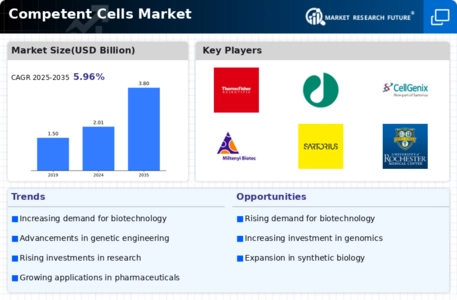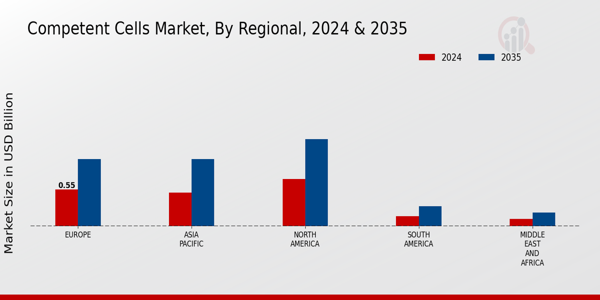Market Growth Projections
The Global Competent Cells Market Industry is poised for substantial growth, with projections indicating a market size of 2.01 USD Billion in 2024 and an anticipated increase to 3.8 USD Billion by 2035. This growth trajectory suggests a robust compound annual growth rate (CAGR) of 5.96% from 2025 to 2035. Such figures reflect the increasing adoption of competent cells across various sectors, including research, pharmaceuticals, and biotechnology. The market's expansion is likely driven by ongoing advancements in genetic engineering, biotechnology investments, and the rising demand for personalized medicine, indicating a vibrant future for the industry.
Increased Investment in Biotechnology
Investment in biotechnology is a significant driver for the Global Competent Cells Market Industry. Governments and private sectors are channeling substantial funds into research and development, fostering an environment conducive to innovation. This influx of capital supports the development of advanced competent cell technologies, enhancing their efficiency and effectiveness. As a result, the market is expected to grow to 3.8 USD Billion by 2035. The financial backing not only accelerates research but also encourages collaborations between academic institutions and industry players, further propelling the adoption of competent cells in various applications, including synthetic biology and genetic modification.
Rising Demand for Genetic Engineering
The Global Competent Cells Market Industry experiences a notable surge in demand driven by advancements in genetic engineering. As researchers increasingly utilize competent cells for cloning, gene expression, and protein production, the market is projected to reach 2.01 USD Billion in 2024. This growth is indicative of the expanding applications of competent cells in biotechnology and pharmaceuticals. The ability to manipulate genetic material efficiently has become crucial for developing novel therapeutics and vaccines. Consequently, the market is likely to witness a compound annual growth rate (CAGR) of 5.96% from 2025 to 2035, reflecting the ongoing innovations in genetic research.
Growing Focus on Personalized Medicine
The shift towards personalized medicine is reshaping the Global Competent Cells Market Industry. As healthcare moves towards tailored treatments based on individual genetic profiles, competent cells play a pivotal role in developing targeted therapies. This trend is likely to drive demand for competent cells, as they are essential for creating genetically modified organisms that can produce specific therapeutic proteins. The increasing prevalence of chronic diseases necessitates innovative solutions, further emphasizing the importance of competent cells in research and development. This focus on personalized medicine may contribute to the market's growth trajectory, aligning with the projected CAGR of 5.96% from 2025 to 2035.
Expanding Applications in Synthetic Biology
The expanding applications of competent cells in synthetic biology are a crucial driver for the Global Competent Cells Market Industry. As synthetic biology continues to evolve, competent cells are increasingly employed for constructing genetic circuits and engineering metabolic pathways. This versatility allows researchers to design organisms with novel functionalities, which is essential for applications ranging from biofuels to pharmaceuticals. The growing interest in synthetic biology is likely to propel the market forward, as it fosters innovation and collaboration among scientists. The anticipated growth trajectory suggests that the market could reach 3.8 USD Billion by 2035, reflecting the increasing reliance on competent cells in this burgeoning field.
Technological Advancements in Cell Transformation
Technological advancements in cell transformation techniques are significantly influencing the Global Competent Cells Market Industry. Innovations such as electroporation, heat shock, and chemical transformation methods enhance the efficiency of competent cells, making them more accessible for various applications. These advancements not only improve transformation rates but also expand the range of host organisms that can be utilized. As researchers seek to optimize their workflows, the demand for high-quality competent cells is likely to increase. This trend aligns with the overall market growth, which is projected to reach 2.01 USD Billion in 2024, driven by the need for more effective genetic manipulation tools.





















